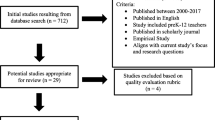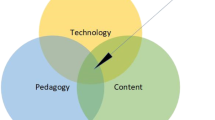Abstract
Decades of declining enrollment trends and additional program closures of Technology and Engineering (T&E) teacher preparation programs in the United States (US) continue to raise concerns about the trajectory and sustainability of the profession. These concerns are not insular to the US though as other countries have also presented data indicating a T&E teacher shortage crisis. In attempts to address these concerning trends, T&E teacher preparation programs in the US have implemented an amalgam of creative recruitment strategies. However, the data continues to show a downward trend in the country, questioning what is the sufficiency of these efforts and which are the most influential? This study surveyed 51 students enrolled in a T&E teacher preparation program in the eastern US to determine which recruitment methods had the greatest influence on their decision to enroll in the program. The findings revealed that face-to-face interactions with secondary level T&E educators, alumni, T&E teacher education faculty members, and an interest in hands-on hobbies related to T&E education were found to have a statistically significant influence on students’ decision to enroll in the T&E teacher preparation program. A number of recruitment factors such as secondary school counselors, brochures, and social media platforms did not have a significant influence on students’ enrollment decision. Recommendations and implications for T&E teacher preparation programs, teacher educators, program alumni, researchers, secondary level T&E teachers, administrators, and school counselors are provided to help countries facing a similar T&E teacher shortage crisis.


Similar content being viewed by others
Availability of data and material
All data generated or analysed during this study are included in this published article [and its supplementary information files].
Code availability
Not applicable.
Notes
Design and Technology Education in the United States is commonly referred to as Technology and Engineering Education.
References
Argyrous, G. (1997). The z-test for a single proportion. In Statistics for Social Research. Palgrave. https://doi.org/10.1007/978-1-349-14777-9_11
Bransberger, P., Falkenstern, C., & Lane, P. (2020). Knocking at the college door: Projections of high school graduates (10th ed.). Western Interstate Commission for Higher Education. https://knocking.wiche.edu/wp-content/uploads/sites/10/2020/12/Knocking-pdf-for-website.pdf
Craft, C. O. (1980). Recruitment of industrial arts education majors-A professional obligation of all industrial arts educators. Man/Society/Technology, 39(5), 21–23
Design and Technology Teachers’ Association Australia (DATTA Australia) (2019). Technologies teacher shortage survey: National overview 2019. https://www.datta.wa.edu.au/wp-content/uploads/2019/10/TECHNOLOGY-TEACHER-SHORTAGE-SURVEY-REPORT-2019-DATTA-AUSTRALIA.pdf
Daugherty, M. (1998). A recruitment crisis: Strategies for affecting change. The Technology Teacher, 57(7), 21–26
Devier, D. H. (1982). The recruitment of industrial arts teacher education students in Ohio with possible implications for the total profession. Journal of Industrial Technology Education, 19(3), 27–38
Edmunds, N. A. (1980). Effective recruiting—A tool to replenish, sustain, and improve the profession. The Journal of Epsilon Pi Tau, 6(1), 17–22
Ernst, J. V., & Williams, T. O. (2015). The “Who, what, and how conversation”: Characteristics and responsibilities of current in-service technology and engineering educators. The Journal of Technology Studies, 41(1), 48–56
Foley, D. J. (1967). Handbook on recruitment of potential industrial arts teachers. New York: New York University
Gray, M., & Daugherty, M. (2004). Factors that influence students to enroll in technology education program. Journal of Technology Education, 15(1), 1–10
House of Commons Education Committee (2017). Recruitment and retention of teachers. HC 199. London. https://publications.parliament.uk/pa/cm201617/cmselect/cmeduc/199/199.pdf
Isbell, C. H., & Lovedahl, G. G. (1989). A survey of recruitment techniques used in industrial arts/technology education programs. The Journal of Epsilon Pi Tau, 15(1), 37–41
Izadi, M., & Toosi, M. (1995). Effective recruitment techniques as identified by students majoring in industrial technology. Journal of Industrial Technology, 11(3), 13–16
Litowitz, L. (2014). A curricular analysis of undergraduate technology & engineering teacher preparation programs in the United States. Journal of Technology Education, 25(2), 73–84
Long, R., & Danechi, S. (2021). Teacher recruitment and retention in England. House of Commons Library Briefing Paper no. 07222. London: House of Commons Libraryhttps://researchbriefings.files.parliament.uk/documents/CBP-7222/CBP-7222.pdf
Love, T. S. (2015). Examining the demographics and preparation experiences of foundations of technology teachers. The Journal of Technology Studies, 41(1), 58–71. https://doi.org/10.21061/jots.v41i1.a.7
Love, T. S., Love, Z. J., & Love, K. S. (2016). Better practices for recruiting T&E teachers. Technology and Engineering Teacher, 76(1), 10–15
Love, T. S., & Maiseroulle, T. (2021). Are technology and engineering educator programs really declining? Reexamining the status and characteristics of programs in the United States. Journal of Technology Education, 33(1), 4–20. https://doi.org/10.21061/jte.v33i1.a.1
Moye, J. J. (2017). The supply and demand of technology and engineering teachers in the United States: Who knows? Technology and Engineering Teacher, 76(4), 32–37
Moye, J. J., Reed, P. A., Wu-Rorrer, R., & Lecorchick, D. (2020). Current and future trends and issues facing technology and engineering education in the United States. Journal of Technology Education, 32(1), 35–49
Nulty, D. D. (2008). The adequacy of response rates to online and paper surveys: What can be done? Assessment and Evaluation in Higher Education, 33(3), 301–314
Reinsfield, E., & Lee, K. (2021). Exploring the technology teacher shortage in New Zealand: The implications for quality teaching and learning. International Journal of Technology and Design Education. https://doi.org/10.1007/s10798-021-09668-4
Ressler, R. (1966). Recruitment of industrial arts teachers in the state of Ohio. [Doctoral dissertation, The Ohio State University]. OhioLINK
Sanders, M. (1986). Recruitment strategies for industrial arts teacher education. The Journal of Epsilon Pi Tau, 12(1), 59–65
Sinn, J. W. (1989). The need for a defensible content base for industrial technology; An editorial. Journal of Industrial Technology, 6(1), 6–8
Soboloski, M. (2003). The current status of graduate and undergraduate programs in technology education. Unpublished manuscript. Department of Technology, State University of New York at Oswego
Starkweather, K. N. (1999). Teacher shortage. In M. R. Karnes (Ed.), Technology education prospect: Perceptions, change, and the survival of the profession. Journal of Technology Studies, 25(1), 27–28
Ujifusa, A. (2018, April 17). Here’s how the public views teachers, their salaries, and their impact. Education Week. https://www.edweek.org/leadership/heres-how-the-public-views-teachers-their-salaries-and-their-impact/2018/04
United States Department of Education (USDOE) (2020). Teacher shortage areas. https://tsa.ed.gov/#/reports
Volk, K. S. (1993). Enrollment trends in industrial arts/technology education programs from 1970–1990. Journal of Technology Education, 4(2), 46–59
Volk, K. S. (1997). Going, going, gone? Recent trends in technology teacher education programs. Journal of Technology Education, 8(2), 67–71
Volk, K. S. (2000). Trends in U.S. technology teacher education programs: Home thoughts from abroad.Journal of Industrial Teacher Education, 37(3). https://scholar.lib.vt.edu/ejournals/JITE/v37n3/volk.html
Volk, K. S. (2019). The demise of traditional technology and engineering education teacher preparation programs and a new direction for the profession. Journal of Technology Education, 31(1), 2–18
Warner, S. A., Erli, L. M., Johnson, C. W., & Greiner, S. S. (2007). Identifying the paradigm of design faculty in undergraduate technology education in the United States. Journal of Technology Education, 18(2), 68–87
Wright, M. D., & Custer, R. L. (1998). Why they want to teach: Factors influencing students to become technology education teachers. Journal of Technology Education, 10(1), https://doi.org/10.21061/jte.v10i1.a.4
Funding
No funding was received for conducting this study.
Author information
Authors and Affiliations
Contributions
Author ZJL designed the study and collected the data. Author TSL drafted the manuscript and conducted the statistical analyses. Both authors contributed to the revision of the manuscript and the approved the final manuscript.
Corresponding author
Ethics declarations
Conflicts of interest/Competing interests
The authors have no conflicts of interest to declare that are relevant to the content of this article.
Additional information
Publisher’s Note
Springer Nature remains neutral with regard to jurisdictional claims in published maps and institutional affiliations.
Appendix A
Appendix A
Survey items
Directions: Please rank the extent to which the following recruitment factors influenced your decision to pursue a career as a Technology and Engineering (T&E) educator. Responses range from 1 to 6, with 1 representing no influence, and 6 representing very influential.
-
1.
University recruiter visited my high school.
-
2.
University social media account.
-
3.
University or program website.
-
4.
Program brochures.
-
5.
Face to face interaction with a faculty member from the program.
-
6.
Interaction(s) with alumni from the program.
-
7.
Positive T&E education job characteristics.
-
8.
Current student(s) in the T&E education program.
-
9.
University open house event.
-
10.
Involvement with Technology Student Association (TSA).
-
11.
High school counselor(s).
-
12.
Friends/peers.
-
13.
Family members.
-
14.
Middle or high school T&E teacher.
-
15.
Interest in hands-on T&E hobbies.
-
16.
Other (please describe).
.
Rights and permissions
About this article
Cite this article
Love, T.S., Love, Z.J. The teacher recruitment crisis: examining influential recruitment factors from a United States technology and engineering teacher preparation program. Int J Technol Des Educ 33, 105–121 (2023). https://doi.org/10.1007/s10798-022-09727-4
Accepted:
Published:
Issue Date:
DOI: https://doi.org/10.1007/s10798-022-09727-4




